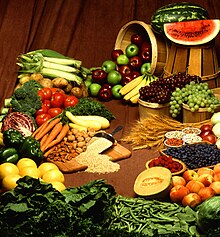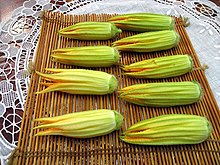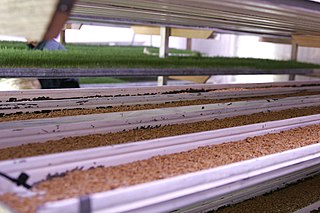Description

The report identifies 12 plant sources and five animal sources that make up 75 percent of the food humans consume, and three crops (wheat, corn and rice) accounting for about "60 percent of the plant-based calories in most diets". [3] The report points out that lack of variety in food sources threatens food security, and "repeatedly harvesting the same crop on the same land depletes nutrients in the soil, leading to intensive use of fertilizers and pesticides that, when misused, can hurt wildlife and damage the environment". [3]
The report offers five steps to identifying a future food: "focus on plant-based foods, optimize nutrient density, evaluate environmental impact, consider culture and flavor, and deliver diversity." [4]
Criteria for inclusion on the list of 50 foods indicated they must be "highly nutritious, have as little impact on the environment as possible, affordable, accessible, and of course, tasty". [4] The foods are grouped into categories:

Algae
Algae contain essential fatty acids and antioxidants rich in protein, and are a potential replacement for meat. [5]
1. Laver seaweed Porphyra umbilicalis
2. Wakame seaweed Undaria pinnatifida
Beans and pulses

Beans are in the legume family, and are a source of fiber, protein and B vitamins. [2]
3. Adzuki beans Vigna angularis
4. Black turtle beans Phaseolus vulgaris
5. Broad beans (fava beans) Vicia faba
6. Bambara groundnuts/Bambara beans Vigna subterranea

7. Cowpeas Vigna unguiculata
8. Lentils Lens culinaris
9. Marama beans Tylosema esculentum
10. Mung beans Vigna radiata
11. Soy beans Glycine max
Cacti
Cacti contains vitamins C and E, carotenoids, fibre and amino acids. [2]
12. Nopales Opuntia
Cereals and grains

These whole grains and cereals provide nutritional value and also improve soil health by diversifying sources of carbohydrates from current dependence on white rice, maize, and wheat. [2]
13. Amaranth Amaranthus
14. Buckwheat Fagopyrum esculentum
15. Finger millet Eleusine coracana
16. Fonio Digitaria exilis

17. Khorasan wheat Triticum turanicum
18. Quinoa Chenopodium quinoa
19. Spelt Triticum spelta
20. Teff Eragrostis tef
21. Wild rice Zizania
Vegetable-like fruits
Compared to vegetables, these fruits are sweeter and usually contain more carbohydrates and water. [2]

22. Pumpkin flowers Cucurbita pepo
23. Orange tomatoes Solanum lycopersicum
24. Okra Abelmoschus esculentus
Leafy greens
Leafy greens contain dietary fiber, vitamins and minerals, and are low in calories. [2]
25. Beet greens Beta vulgaris
26. Broccoli rabe Brassica ruvo
27. Kale Brassica oleracea var. sabellica
28. Moringa Moringa oleifera
29. Pak-choi or bok-choy (Chinese cabbage) Brassica rapa subsp. chinensis

30. Pumpkin leaves Cucurbita pepo
31. Red cabbage Brassica rapa subsp. chinensis
32. Spinach Spinacia oleracea
33. Watercress Nasturtium officinale
Mushrooms
Mushrooms have high B vitamin content, as well as vitamin D, protein, and fiber. [2]
34. Enoki mushrooms Flammulina velutipes
35. Maitake mushrooms Grifola frondosa
36. Saffron milk cap mushrooms Lactarius deliciosus

Nuts and seeds
Called "superfoods", these foods are high in protein, vitamin E, and "good fats". [2]
37. Flax seeds Linum usitatissimum
38. Hemp seeds Cannabis sativa
39. Sesame seeds Sesamum indicum
40. Walnuts Juglans regia

Root vegetables
Root vegetables have a broad variety of vitamins and minerals. [2]
41. Black salsify Scorzonera hispanica
42. Parsley root Petroselinum crispum
43. White icicle radish (winter radish) Raphanus sativus var. Longipinnatus

Sprouts
Sprouts extremely high nutrient content. The sprouting process doubles, and in some cases triples, the nutritional value of the plant. [2]
44. Alfalfa sprouts Medicago sativa
45. Sprouted kidney beans Phaseolus vulgaris
46. Sprouted chickpeas Cicer arietinum
Tubers

Tubers are usually high in carbohydrates and are a source of energy. [2]
47. Lotus root Nelumbo nucifera
48. Ube (purple yam) Dioscorea alata
49. Yam bean root (jicama) Pachyrhizus erosus
50. Red Indonesian (Cilembu) sweet potatoes Ipomoea batatas

















